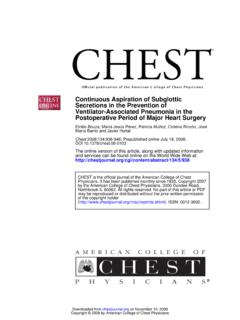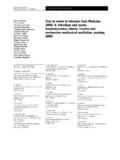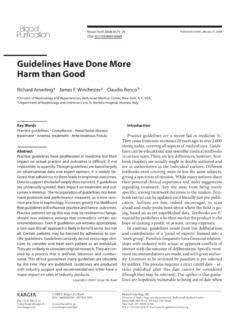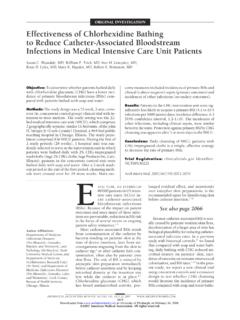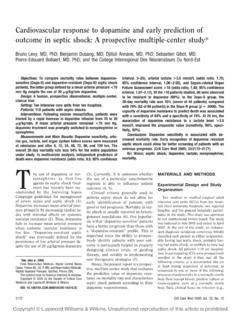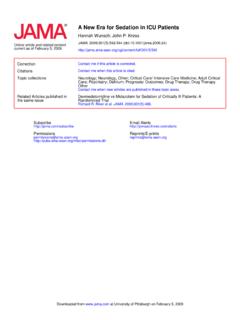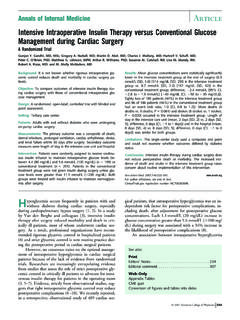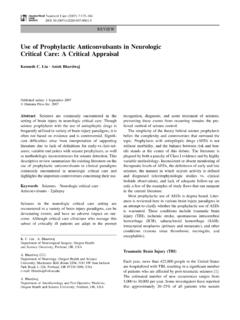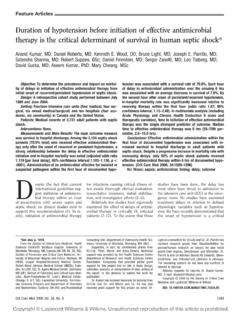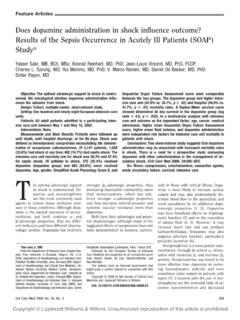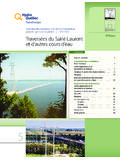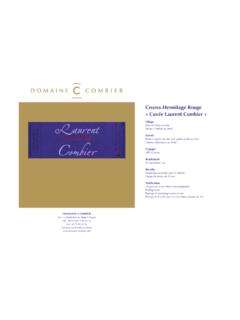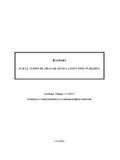Transcription of Burnout syndrome among critical care healthcare workers ...
1 Burnout syndrome among critical care healthcare workers Nathalie Embriaco, Laurent Papazian, Nancy Kentish-Barnes, Frederic Pochard and Elie Azoulay Purpose of review Introduction Burnout syndrome is a psychological state resulting from Burnout is a psychological term (concept) for the experi- prolonged exposure to job stressors. Because ICUs are ence of long-term exhaustion and diminished interest characterized by a high level of work-related stress, a factor (depersonalization or cynicism), usually in the work con- known to increase the risk of Burnout syndrome , we sought text. Burnout is often construed as the result of a period of to review the available literature on Burnout syndrome in ICU expending too much effort at work while having too little healthcare workers . recovery. healthcare workers are often prone to Burnout . Recent findings Still, Burnout can affect workers of any kind, including Based on most recent studies, severe Burnout syndrome students. High stress jobs can lead to more Burnout than (as measured using the Maslach Burnout Inventory) is lower stress work.
2 Present in about 50% of critical care physicians and in one third of critical care nurses. Strikingly, determinants of Burnout syndrome (BOS) [1] was identified in the early Burnout syndrome are different in the two groups of 1970s in human service professionals, most notably caregivers. Namely, intensivists who have severe Burnout healthcare workers [2]. BOS has been described as an syndrome are those with a high number of working hours inability to cope with emotional stress at work [3] or as (number of night shifts and time from last vacation) but excessive use of energy and resources leading to feelings determinants of severe Burnout syndrome in ICU-nurses are of failure and exhaustion [4]. Clinical symptoms of BOS. related to ICU organization and end-of-life-related are nonspecific and include tiredness, headaches, eating characteristics. ICU conflicts, however, were independent problems, insomnia, irritability, emotional instability, and predictors of severe Burnout syndrome in both groups.
3 Rigidity in relationships with other people. The most well Summary studied measurement of Burnout in the literature is the Recent studies reported high levels of severe Burnout Maslach Burnout Inventory (MBI). Maslach and her col- syndrome in ICU healthcare workers and identified potential league Jackson [2] first identified the construct Burnout '. targets for preventive strategies such as ICU working in the 1970s, and developed a measure that weighs the groups, communication strategies during end-of-life care effects of emotional exhaustion, depersonalization (nega- and prevention and management of ICU conflicts. tive or cynical attitudes toward patients), and reduced sense of personal accomplishment. This indicator has Keywords become the standard tool for measuring Burnout in conflicts, depression, end-of-life care , exhaustion, intensive research on the syndrome . People who experience all care three symptoms have the greatest degree of Burnout , although emotional exhaustion has been identified as the Curr Opin Crit care 13:482 488.
4 2007 Lippincott Williams & Wilkins. hallmark of Burnout [5,6]. Intensive care Unit, Saint-Louis and Sainte Marguerite Teaching Hospitals, Assistance Publique Ho pitaux de Paris, University Paris 7, Paris and Assistance Wide variations in the prevalence of BOS in healthcare Publique, Ho pitaux de Marseille, Marseille, France professionals have been reported across specialties, both Correspondence to E lie Azoulay, MD, PhD, Service de Re animation Me dicale, in doctors [7] and in nurses [8]. Workplace climate and Ho pital Saint-Louis, 1 avenue Claude Vellefaux, 75010 Paris, France workload were determinants of BOS [9]. Higher levels of Tel: +33 142 499 421; fax: +33 142 499 426;. e-mail: severe BOS, however, were found in oncologists [10], anaesthesiologists [11], physicians caring for patients with Current Opinion in critical care 2007, 13:482 488. AIDS [12], and physicians working in emergency depart- Abbreviations ments [13]. BOS Burnout syndrome IQR interquartile range MBI Maslach Burnout Inventory ICUs are characterized by a high level of work-related stress [14], a factor known to increase the risk of BOS [15].
5 2007 Lippincott Williams & Wilkins High rates of severe BOS were reported in ICU nurses as 1070-5295 early as 1987 [16]. BOS is associated with decreased well being among nursing staff members [17], decreased quality of care [18 20], and costs related to absenteeism and high turnover [21], all of which have particularly 482. Copyright Lippincott Williams & Wilkins. Unauthorized reproduction of this article is prohibited. Burnout syndrome Embriaco et al. 483. devastating consequences in the ICU. Few studies have among people working in human services and healthcare addressed the prevalence and determinants of BOS in [1,4,6]. Burnout is a psychological state resulting from ICUs. A study based on the MBI showed a high rate of prolonged exposure to job stressors. According to BOS among ICU physicians, with determinants related to Maslach and colleagues [2], this syndrome is specific to both patient care and inadequate support [22]. Similarly, the work context in contrast with depression which con- studies in ICU nurses indicated that BOS was common cerns professional and private life.
6 BOS has three dimen- and preventive strategies were urgently needed [23,24]. sions: emotional exhaustion, depersonalization (or cyni- cism) and a sense of low personal accomplishment (Fig. 1). In addition, recent ICU studies have highlighted import- [6]. Emotional exhaustion is the key component of BOS. ant levels of ICU burden in critical care nurses. Mealer The symptoms of Burnout are nonspecific and include and colleagues [25 ] surveyed 351 ICU and general irritability, emotional instability, rigidity in relationships nurses from three different hospitals and then surveyed with colleagues and organic complaints such as eating 140 ICU nurses. Anxiety and depression were common in problems, tiredness or sleep disorders. both groups. ICU nurses, however, had an increased prevalence of posttraumatic stress disorder (PTSD) The MBI is a 22-item questionnaire developed by symptoms when compared with other general nurses Maslach et al. [6] for measuring the severity of Burnout .
7 [25 ]. Our study group recently conducted two large The inventory asks respondents to indicate on a seven- longitudinal studies in France [26 ,27 ]. We surveyed point Likert scale the frequency with which they experi- 978 intensivists and 2392 critical care nurses. Approxi- ence certain feelings related to their job. Maslach charac- mately one-half of the intensivists and one third of the terizes three levels of Burnout : low, moderate and high. nurses reported a high level of Burnout . The determi- The MBI evaluates the three domains of the BOS by nants of Burnout were different in intensivists and nurses. independent subscales. It is the most widely employed measure and has high reliability and validity. According In this study we will review data from the literature to the studies, Burnout is defined by a high score of on Burnout syndrome in critical care healthcare workers . depersonalization subscale or a high score of emotional Our main objective is to emphasize that a significant part exhaustion subscale [18] or a high total score [26 ,27 ].
8 Of Burnout is preventable and that some of the deter- minants of severe Burnout are amenable to preventive Burnout occurs primarily in care professions including strategies. physicians [28,29], nurses [30,31] or educators. Over the past 20 years, several studies reported a high preva- Defining the Burnout syndrome lence rate of Burnout in healthcare professionals, both in As stated above, the concept of Burnout describes the doctors and in nurses. In a survey of psychiatric nurses, relationships that people have with their job especially 42% of respondents exhibited a high level of emotional Figure 1 Distribution of the three different subscales explored by the Maslach Burnout Inventory questionnaire in French intensivists Adopted with permission from American Thoracic Society [26 ]. Copyright Lippincott Williams & Wilkins. Unauthorized reproduction of this article is prohibited. 484 critical care outcomes exhaustion [31]. Burnout is frequent among physicians the critical values for emotional exhaustion.
9 among the with rates ranging from 25 to 60% [28,32 36], depending demographic factors, female sex appeared to be associ- on the working conditions and medical specialty [7,29]. ated with a higher rate of Burnout . In the study conducted Studies of Burnout in practicing physicians have shown in French adult ICUs from public hospitals, only female that Burnout can develop at any stage in the career of a sex was shown to be an independent risk factor for physician [28,32]. In a study focused on internal medicine Burnout [26 ]. A representative, random stratified residents, 76% of respondents met a high level of BOS sample of nearly 6000 US physicians in primary and [18]. Determinants of Burnout consist of job character- non surgical care showed that female physicians were istics, demographic variables (sex, age) and personality 60% more likely than male physicians to report signs or traits. Many aspects of professional practice have changed symptoms of Burnout [41]. for both doctors and nurses and include lack of autonomy, decreased resources and the requirement of a high level Workload is usually associated with Burnout .
10 The work- of competence and technical support [14]. Workload, load of ICU physicians is physically demanding, allows stressful work environments like intensive care units limited rest and is associated with sleep deprivation [14,37], severity of illness [38] and conflicts with co- and objective markers of physiologic stress (ketonuria, workers or with patients, may be risk factors for BOS arrhythmia or heart rate abnormalities) [42]. The French [26 ,27 ]. survey reported that the number of on-duties per month, a long delay from the last nonworking week, and being on Burnout among intensivists duty the day before the survey were associated with a The first study to evaluate ICU physicians included 253 higher level of MBI score [26 ]. Also, poor work organ- members of the Section of Internal Medicine of the ization is associated with more stress and produces burn- Society of critical care Medicine [22]. The authors out. In the study by Shanafelt et al. [18] performed in [22] reported high emotional exhaustion and depersona- internal medicine residents, frequent 24-h shifts as well lization MBI subscale scores, and a decreased personal as inadequate leisure time appeared as major stressors achievement subscale score.
